
WESTSIDE MARKET
MRC CAMERAS
Eastman Kodak Company
No. 1 Panoram Kodak Camera (1900-1926)
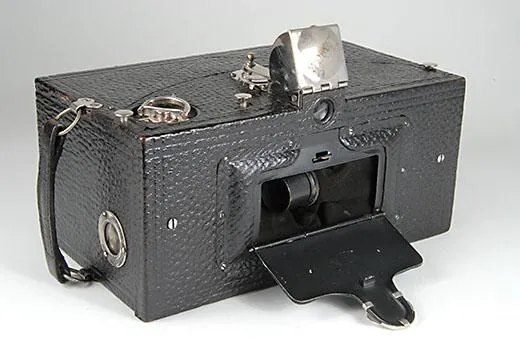
The No. 1 Panoram Kodak was one of the earliest successful panoramic cameras, produced by Eastman Kodak from 1900 until 1926. Designed for ease of use, it was marketed to travelers, adventurers, and amateur photographers who wanted to capture sweeping landscapes.
~ Unique Feature: The camera used a swing-lens mechanism that pivoted during exposure, allowing it to capture a wide 112° panoramic view on roll film. This innovation created dramatic, curved horizon shots that were impossible with standard box cameras of the time.
~ Film Format: It used No. 105 roll film, producing negatives measuring 2¼ x 7 inches.
~ Construction: Made of sturdy leather-covered wood with metal fittings, the camera had a simple yet elegant design, typical of Kodak’s craftsmanship in the early 20th century.
~ Popularity: The Panoram was favored by travelers, explorers, and military personnel for its portability and ability to document expansive scenes—from landscapes to group portraits.
~ Historical Significance: It represents an important step in making panoramic photography accessible to the general public, long before modern wide-angle lenses.
~ Collectibility: Today, the No. 1 Panoram Kodak is prized by collectors for its historical importance, distinctive design, and the unique panoramic images it produced. Surviving examples are considered both display-worthy antiques and fascinating pieces of photographic history.
Eastman Kodak Company
No. 3A Autographic Folding Camera
(1914-1934)
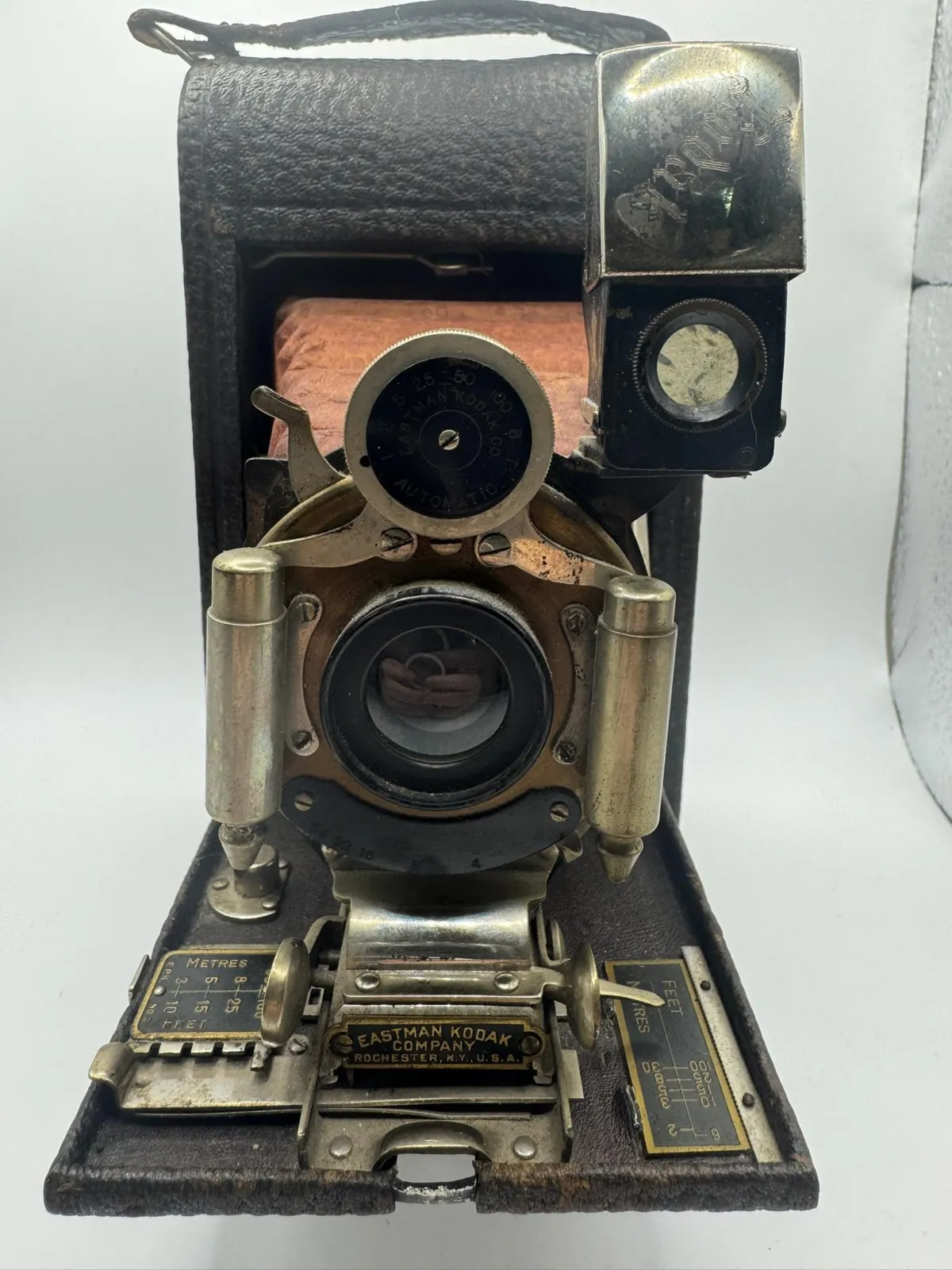
Made by the Eastman Kodak Company of Rochester, New York, the No. 3A Autographic was designed for postcard-size photographs (3¼ x 5½ inches) using 122 roll film. It features Kodak’s Autographic system, which allowed photographers to write notes directly onto the film through a small window in the back. Popular among amateur photographers in the 1910s–1920s, this model combined portability with professional-quality large negatives.
Historical Context: The Autographic line marked a major innovation in consumer photography, giving users a way to document not only images but also dates, names, and notes. These cameras were heavily marketed as the ideal family and travel companion.
Production Years: 1914–1934
Film Type: 122 Roll Film (discontinued)
Eastman Kodak Company
No. 3A Folding Pocket Kodak
(1903-1915)
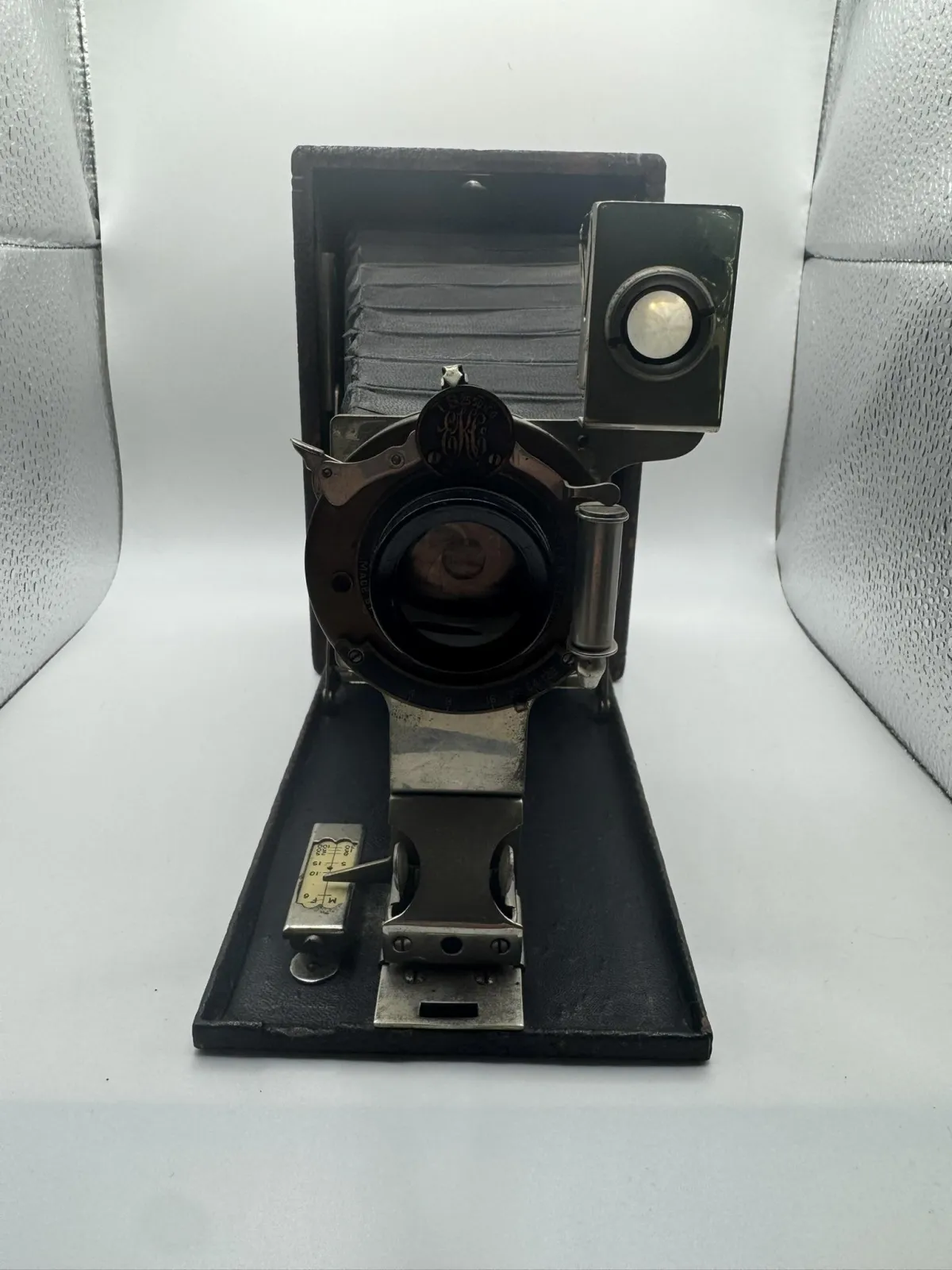
The Kodak No. 3A Folding Pocket Kodak was one of Eastman Kodak’s most successful cameras of the early 20th century. Designed to use 122 roll film, it produced postcard-size negatives (3¼ × 5½ inches), perfect for the booming postcard craze of the 1900s–1910s. Its folding design made it portable yet capable of professional-quality images, appealing to both amateurs and serious photographers.
This example features the original bellows, lens and shutter assembly with the EKC (Eastman Kodak Company) monogram, a brilliant finder, and the classic drop-bed focusing scale.
Production Years: 1903–1915
Format: 122 roll film (postcard size)
Historical Significance: Popularized personal postcard photography in the early 1900s.
Eastman Kodak Company
No. 1A Pocket Kodak (1926–1932)
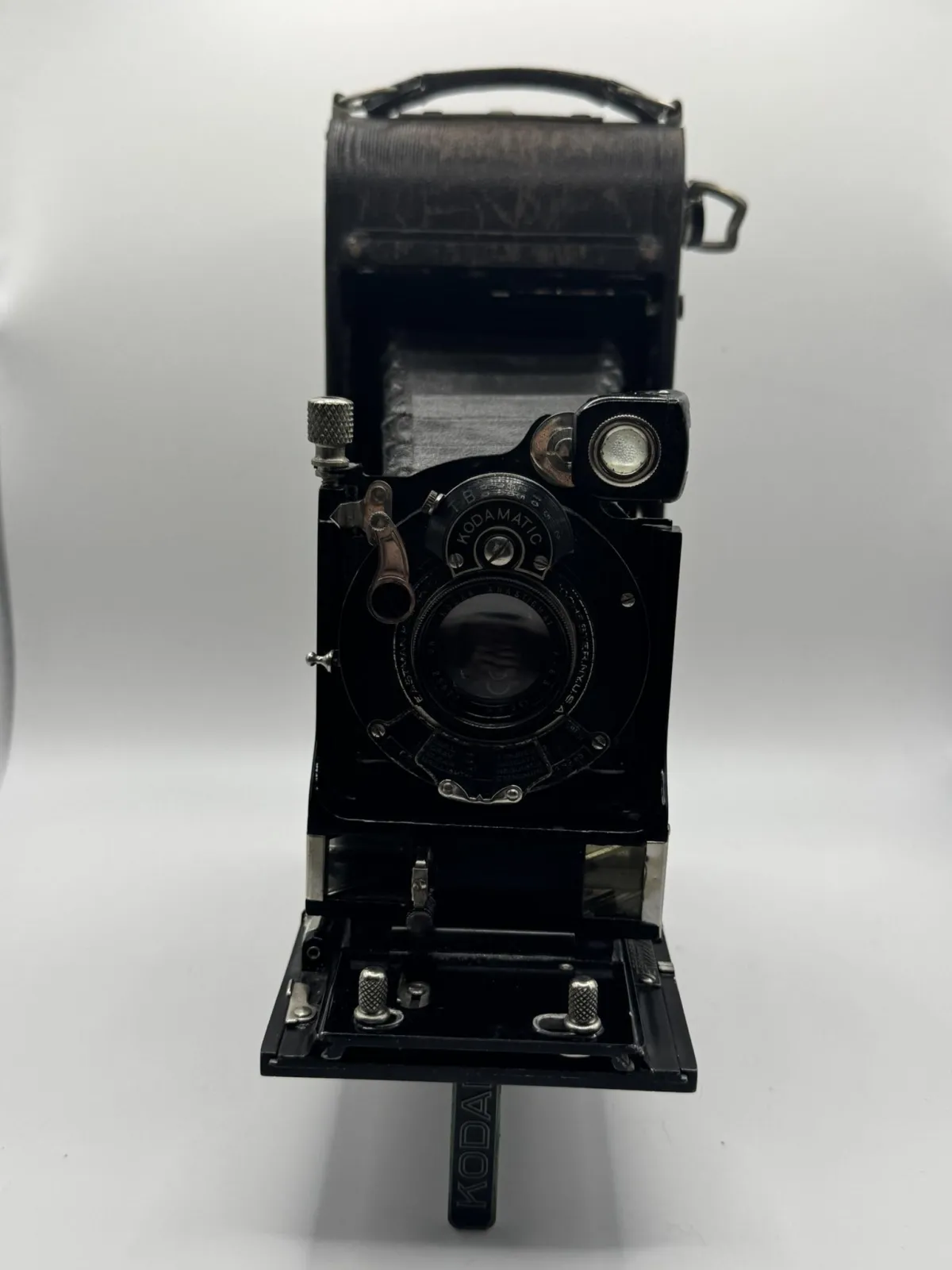
The Kodak No. 1A Pocket Kodak was a sleek, folding camera designed to bring quality photography into the hands of everyday users. It used 116 roll film, producing negatives approximately 2½ × 4¼ inches, slightly larger than the postcard format. Compact and portable, it was marketed as a “pocket” camera, although in modern terms it is closer to a small handbag size.
This model features a Kodamatic shutter with multiple speeds and a brilliant finder, offering photographers of the late 1920s a combination of portability and versatility. Its drop-bed design and leather handle make it one of the more attractive folding Kodaks of the era.
Production Years: 1926–1932
Format: 116 roll film (2½ × 4¼ in negatives)
Historical Significance: Popular mid-range Kodak camera during the late 1920s–1930s, bridging the gap between simple box cameras and professional folding cameras.
Eastman Kodak Company
Kodak Duaflex II (1950–1954)
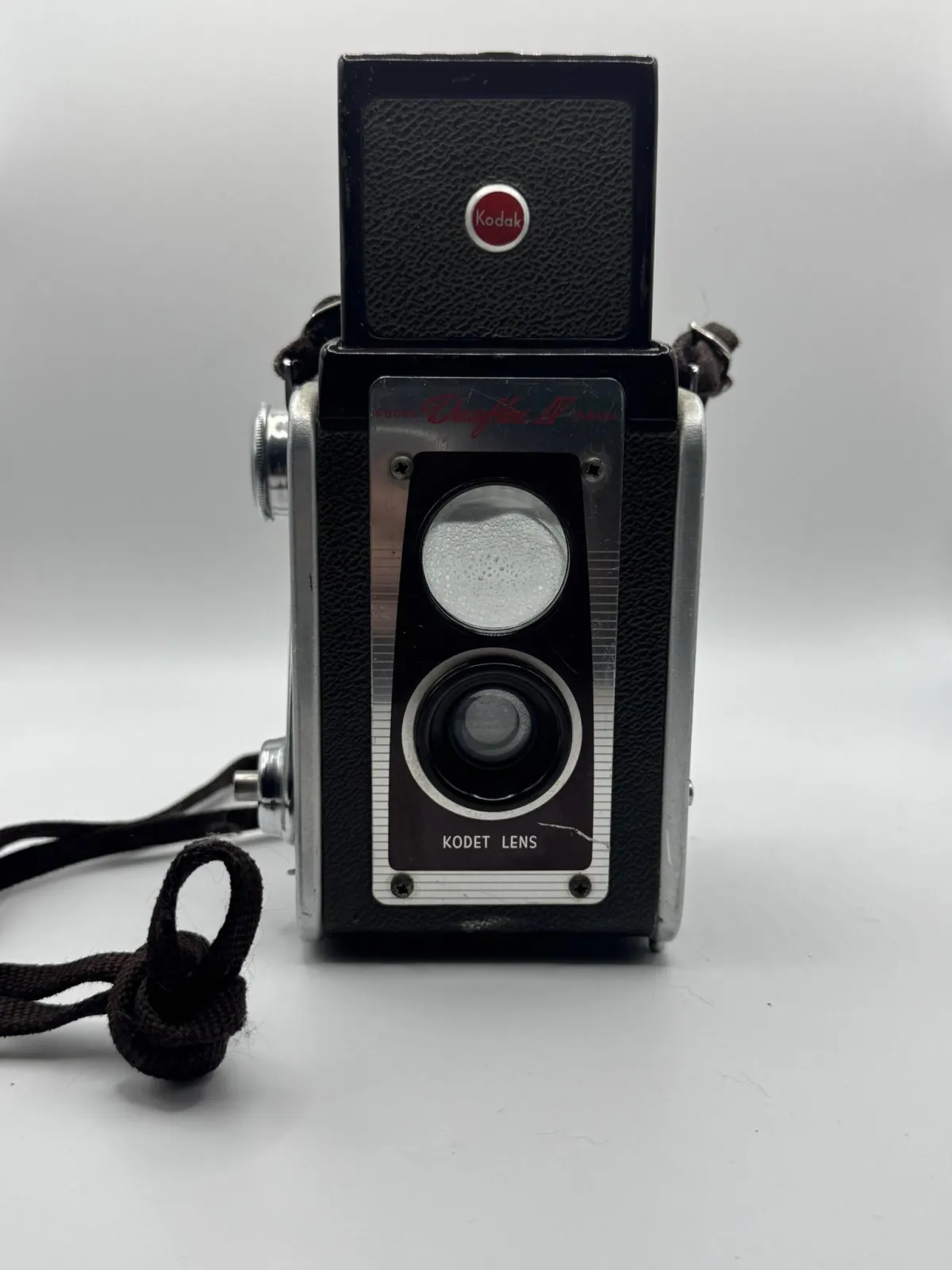
The Kodak Duaflex II is a mid-century classic, produced by Eastman Kodak between 1950 and 1954. Styled like a twin-lens reflex camera, it features a large waist-level finder for easy composing and a simple Kodet lens for snapshot photography.
It used 620 roll film, producing 6×6 cm square negatives (2¼ × 2¼ inches). Popular with amateur photographers, the Duaflex II was affordable, reliable, and part of Kodak’s effort to make medium-format photography accessible to families and hobbyists.
Production Years: 1950–1954
Format: 620 roll film (6×6 cm negatives)
Historical Significance: Mid-century “pseudo TLR,” an iconic family camera of the 1950s.
Eastman Kodak Company
Kodak Six-20 Art Deco Box Camera (1932–1937)
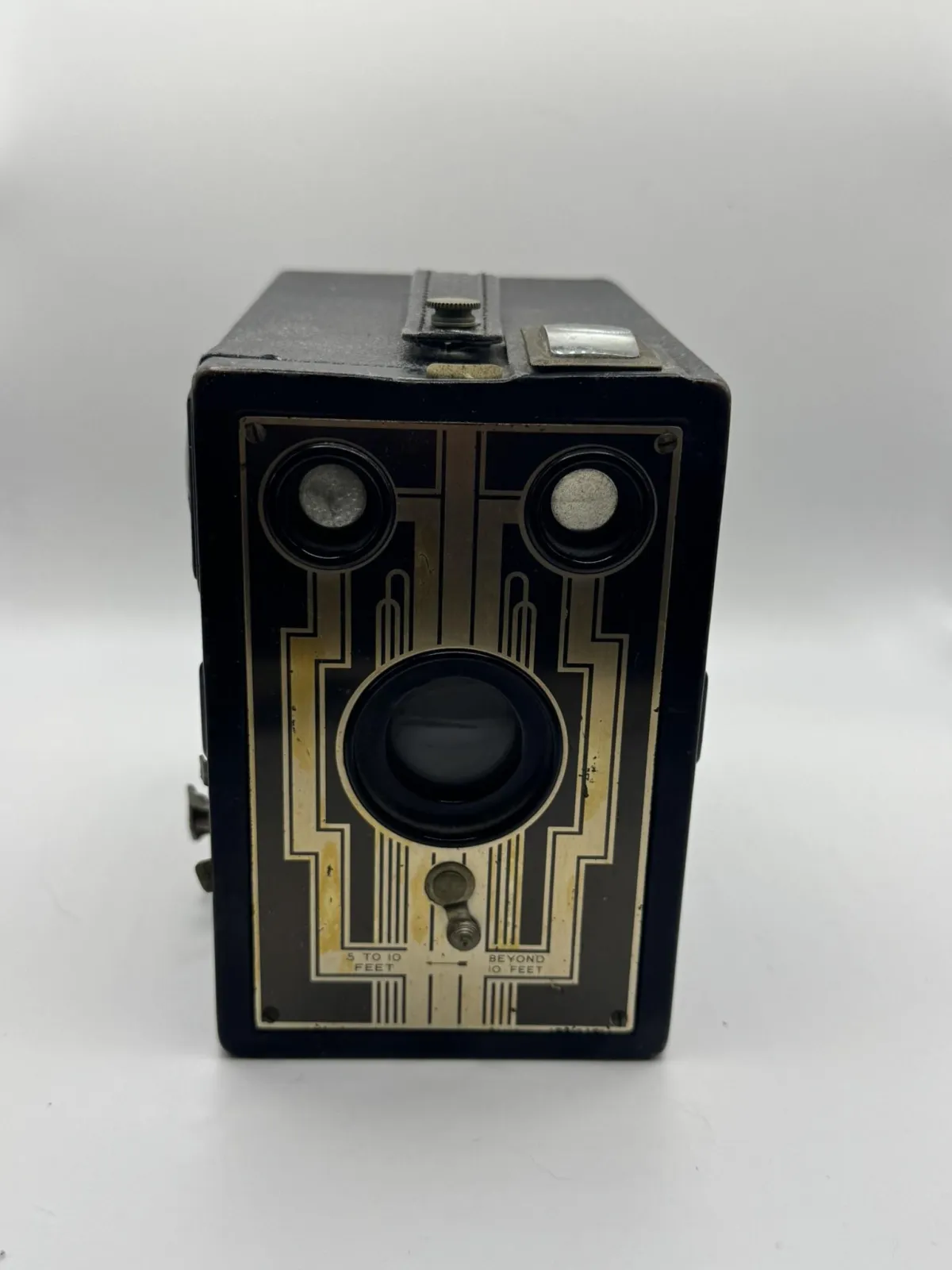
The Kodak Six-20 "Art Deco" Box Camera is one of Kodak’s most iconic designs of the 1930s. Produced from 1932 to 1937, it featured a striking black-and-silver Art Deco faceplate that has made it highly collectible today.
Simple to operate, it used 620 roll film, producing 6×9 cm negatives (2¼ × 3¼ inches). Aimed at casual photographers, this box camera combined affordability with style, making it a household favorite during the Great Depression.
Production Years: 1932–1937
Format: 620 roll film (6×9 cm negatives)
Historical Significance: Known as the “Art Deco Kodak,” prized today for its bold design.
Eastman Kodak Company
Kodak Brownie Target Six-16 (1946–1951)
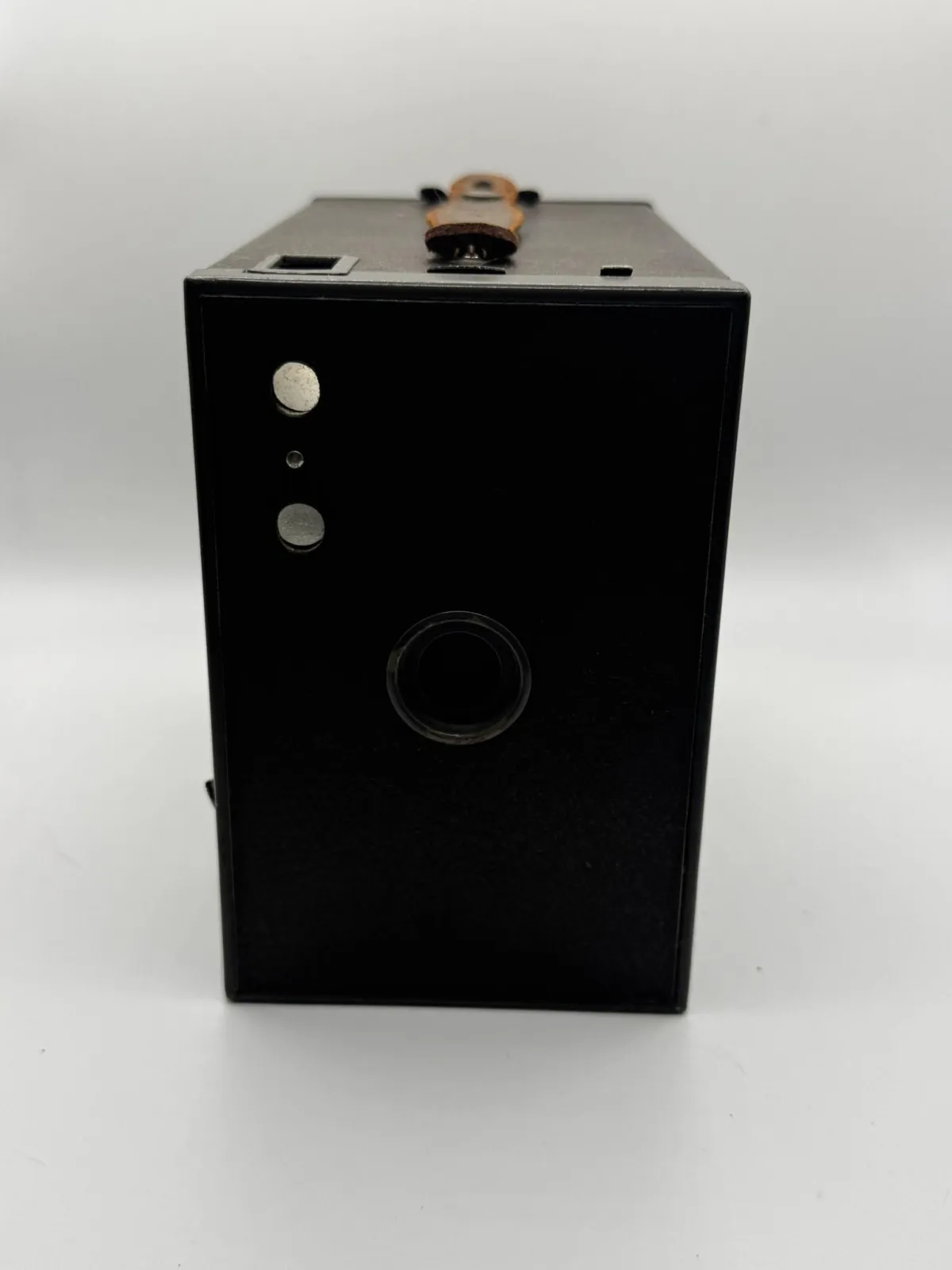
The Kodak Brownie Target Six-16 is a postwar box camera designed for simplicity and reliability. Produced between 1946 and 1951, it was part of Kodak’s long-running Brownie line that revolutionized snapshot photography.
It used 616 roll film, producing large 2½ × 4¼ inch negatives, offering good contact prints without the need for enlargements. The camera features dual viewfinders (for portrait and landscape orientation), a leather strap, and a classic black box design.
Production Years: 1946–1951
Format: 616 roll film (2½ × 4¼ inch negatives)
Historical Significance: An affordable postwar camera that continued Kodak’s tradition of making photography accessible to everyday families.
Eastman Kodak Company
Kodak Beau Brownie No. 2A (1930–1933)
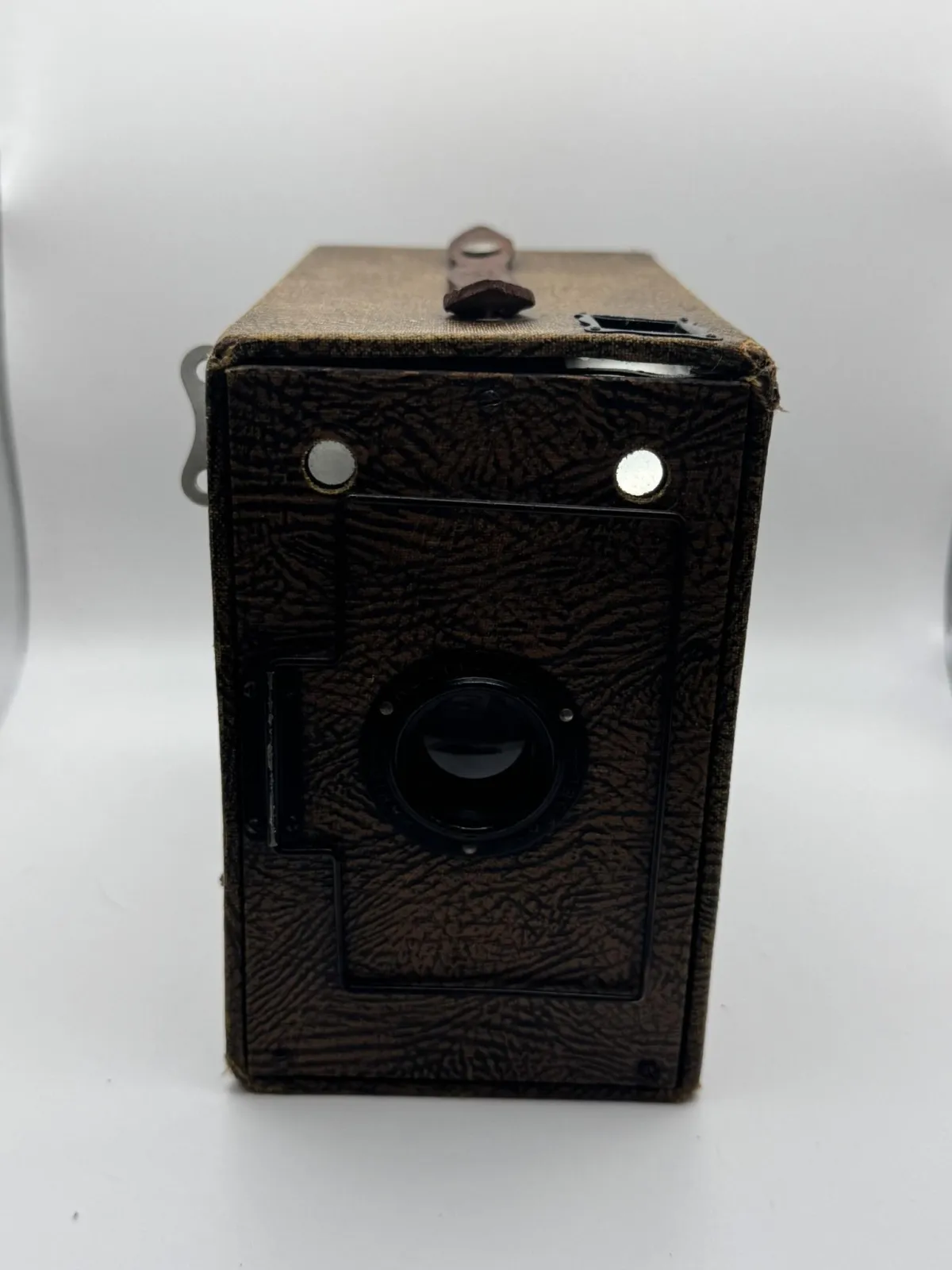
The Kodak Beau Brownie series, produced from 1930 to 1933, represented Kodak’s effort to merge style with photography. Designed by famed industrial designer Walter Dorwin Teague, these cameras featured bold Art Deco styling and colorful faceplates, making them some of the most striking box cameras ever produced.
This example is the No. 2A, covered in brown leatherette. It used 116 roll film, producing negatives of 2¼ × 4¼ inches — perfect for snapshot photography during the early 1930s. The Beau Brownie line is highly collectible today because of its unique combination of design history and photographic heritage.
Production Years: 1930–1933
Format: 116 roll film (2¼ × 4¼ inch negatives)
Historical Significance: Designed by Walter Dorwin Teague; one of the most stylish box cameras ever made.
Pho-Tak Corporation
Pho-Tak Spectator Flash 120 (1947–1953)
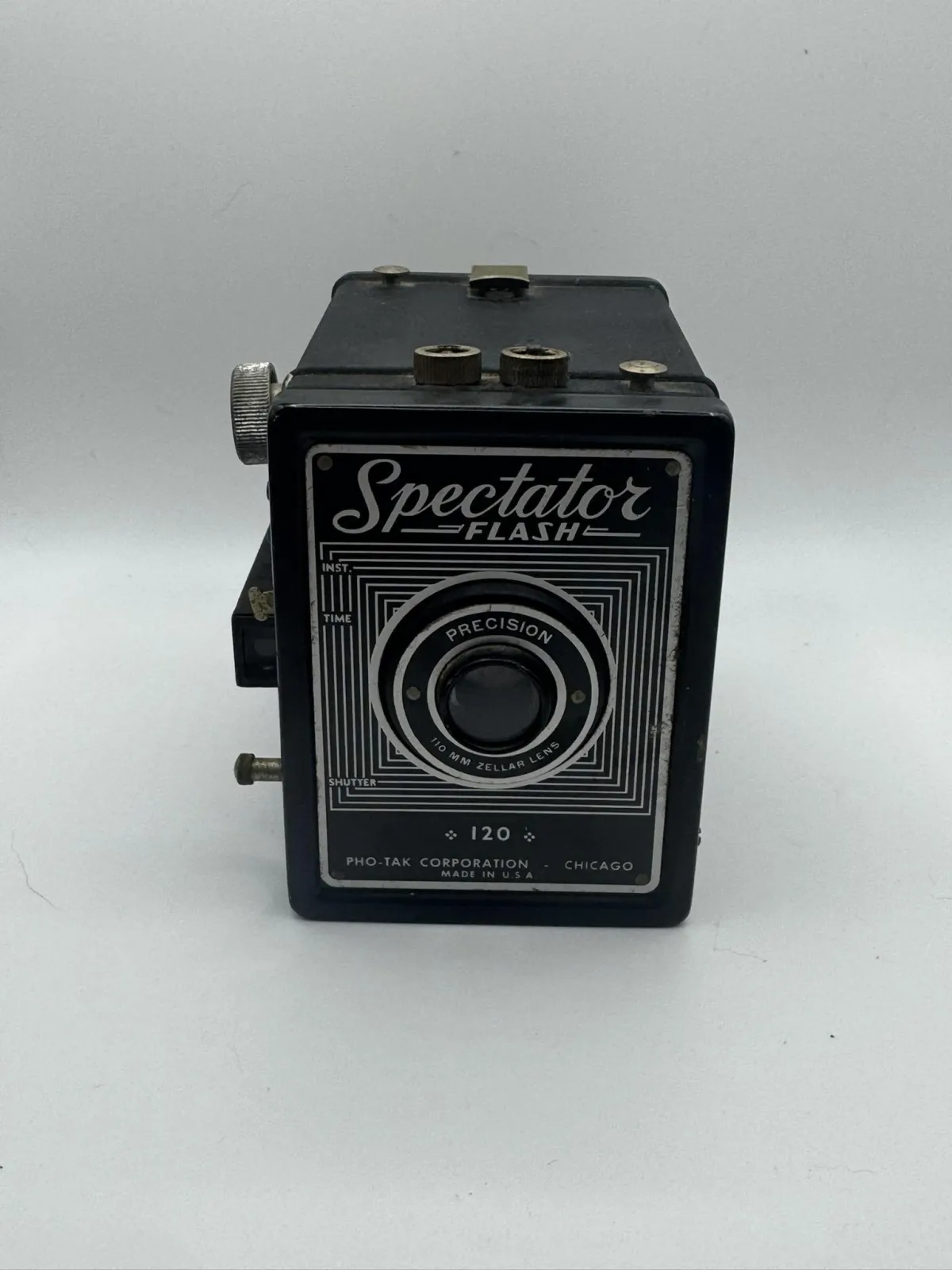
Made in Chicago by the Pho-Tak Corporation, the Spectator Flash 120 is a mid-century American box camera designed for 120 roll film. Its bold geometric faceplate and branding reflect the lingering Art Deco influence of the 1940s, making it visually striking even by today’s standards.
The camera features a 110mm Zellar lens with a simple shutter (instantaneous & time), making it a budget-friendly snapshot camera in its day. Though overshadowed by Kodak, Pho-Tak filled a niche for inexpensive yet stylish cameras in postwar America.
Production Years: Late 1940s – Early 1950s
Film Format: 120 roll film (6×9 cm images)
Lens: 110mm Zellar meniscus
Historical Note: Produced by Pho-Tak, a smaller Chicago-based competitor to Kodak.
Eastman Kodak Company
Kodak Vigilant Six-20 (1939–1949)
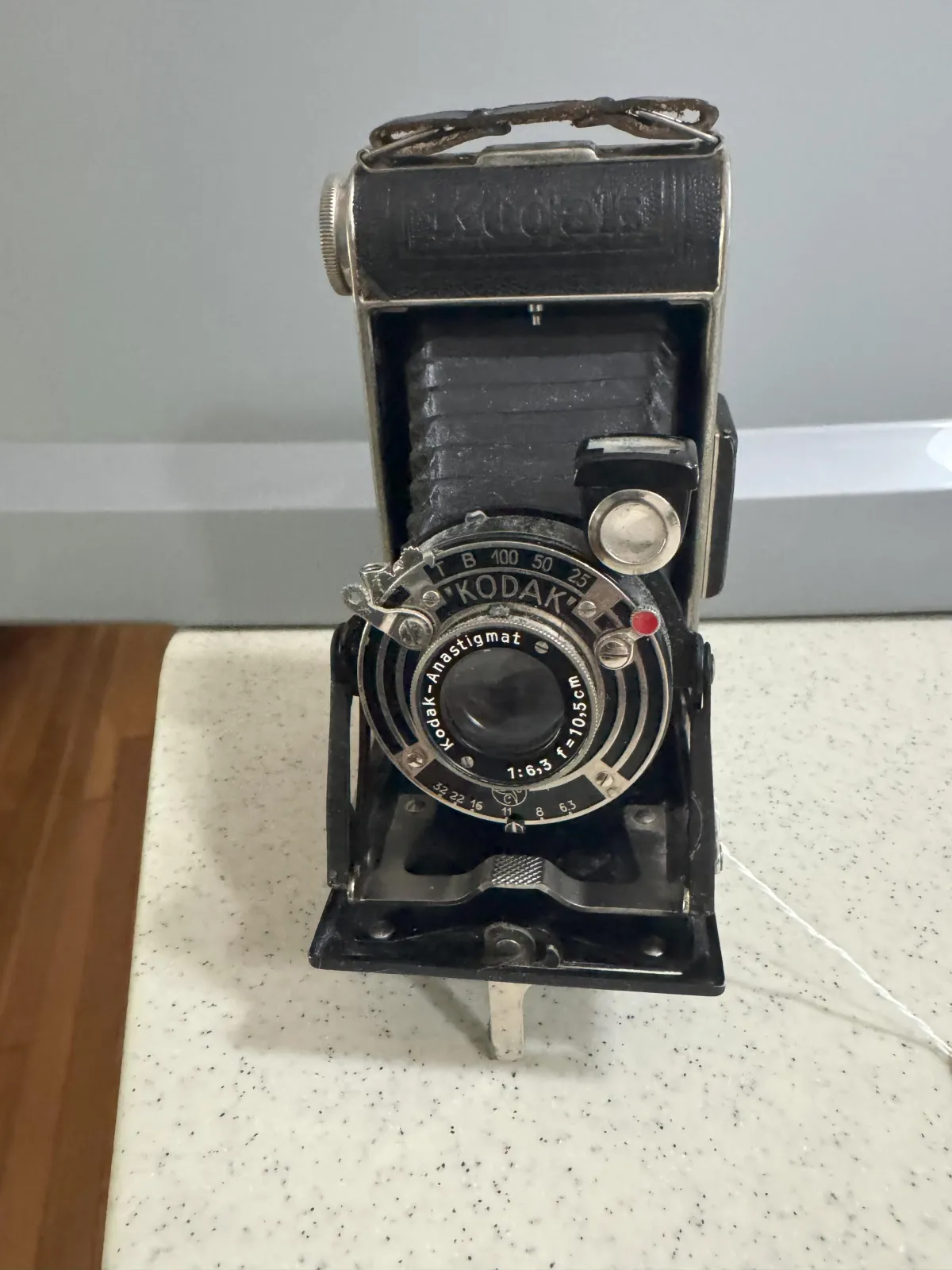
The Kodak Vigilant Six-20 was a popular folding camera designed for 620 roll film, producing large 2¼ x 3¼ inch negatives. This made it ideal for amateur photographers who wanted sharp contact prints without enlarging equipment. Equipped with a Kodak Anastigmat lens, it offered reliable performance at an affordable price, bridging the gap between simple box cameras and higher-end models.
Historical Context: Introduced just before WWII, the Vigilant line carried through the 1940s as a dependable travel and family camera. Its folding design made it compact enough to carry while still delivering professional-looking results.
Production Years: 1939–1949
Film Type: 620 Roll Film (discontinued)
Eastman Kodak Corporation
No. 2 Folding Autographic Brownie (1915–1926)
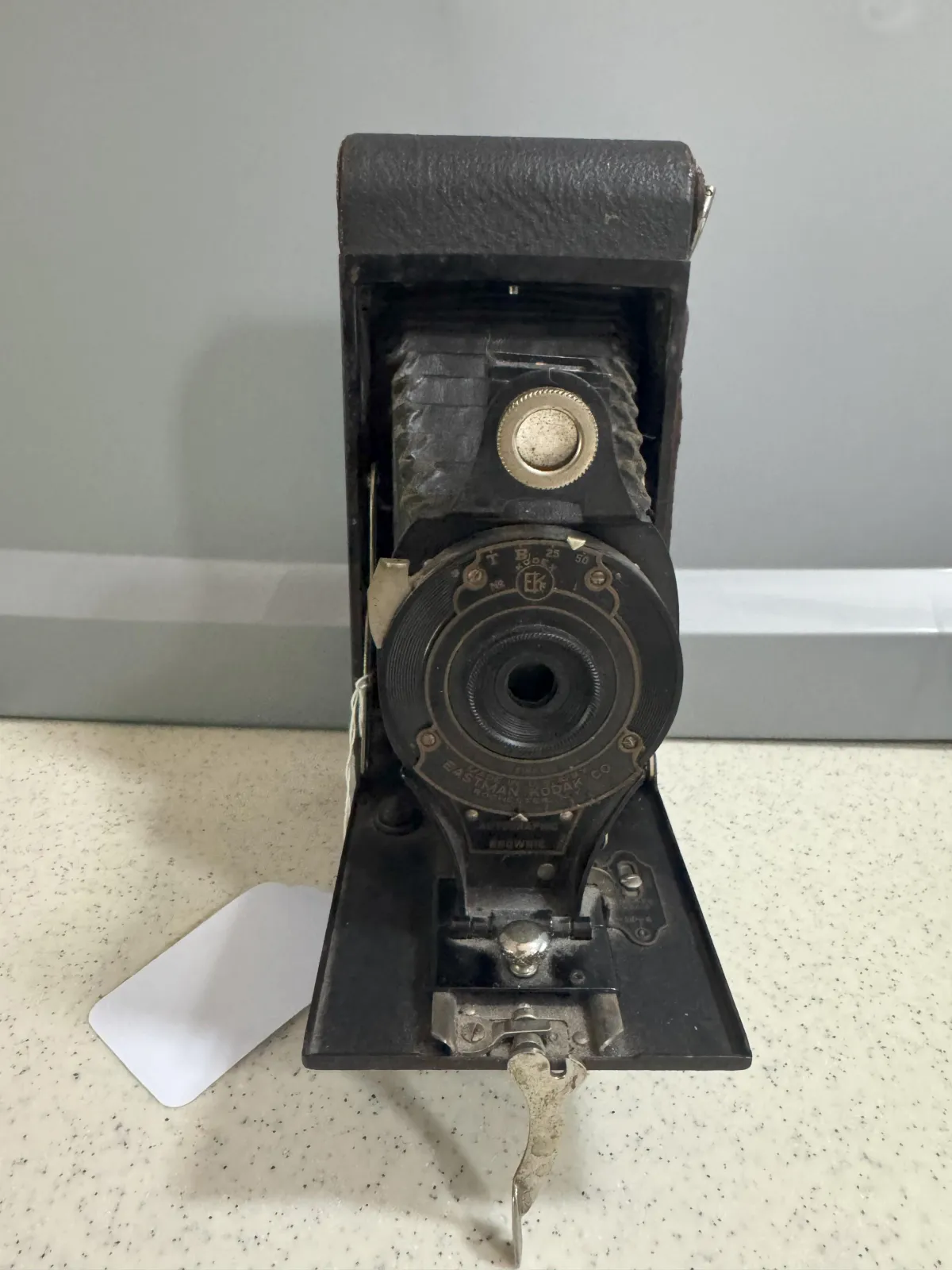
One of Kodak’s most successful folding cameras, the No. 2 Autographic Brownie was designed for 120 roll film—a film size that still exists today. It produced 2¼ x 3¼ inch negatives, making it a favorite among amateur photographers. The “Autographic” feature allowed users to write notes on the film backing using a stylus and small window, a unique innovation of its time.
Historical Context: Introduced during the golden age of film photography, this Brownie brought portability and affordability to the masses. It was especially popular for family portraits, travel, and documenting everyday life during and after World War I.
Production Years: 1915–1926
Film Type: 120 Roll Film (still available)
Kodak Motormatic
Custom Lamp
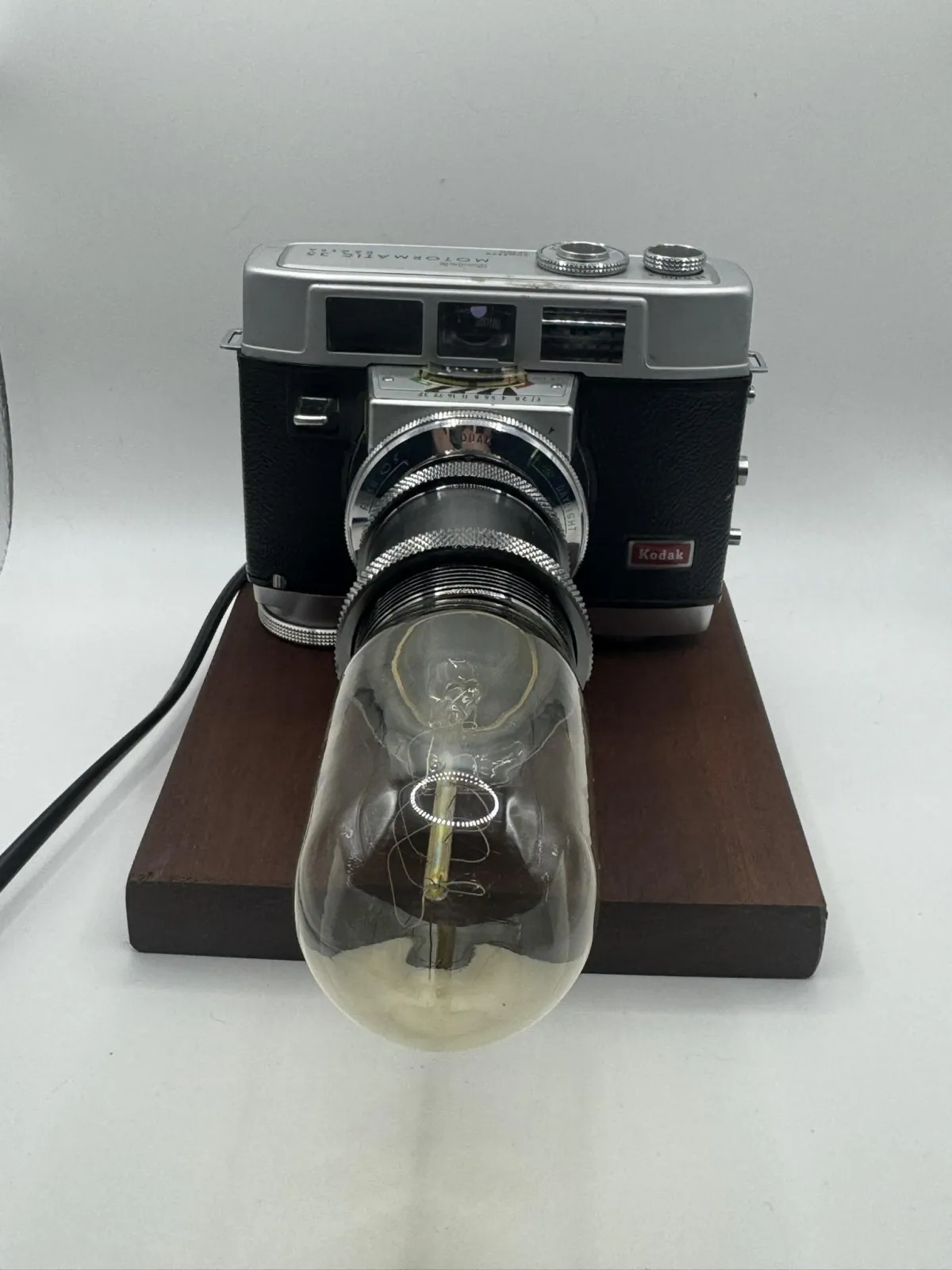
Kodak Motormatic - Customer Lamp
Kodak Brownie Flash 6
Custom Lamp
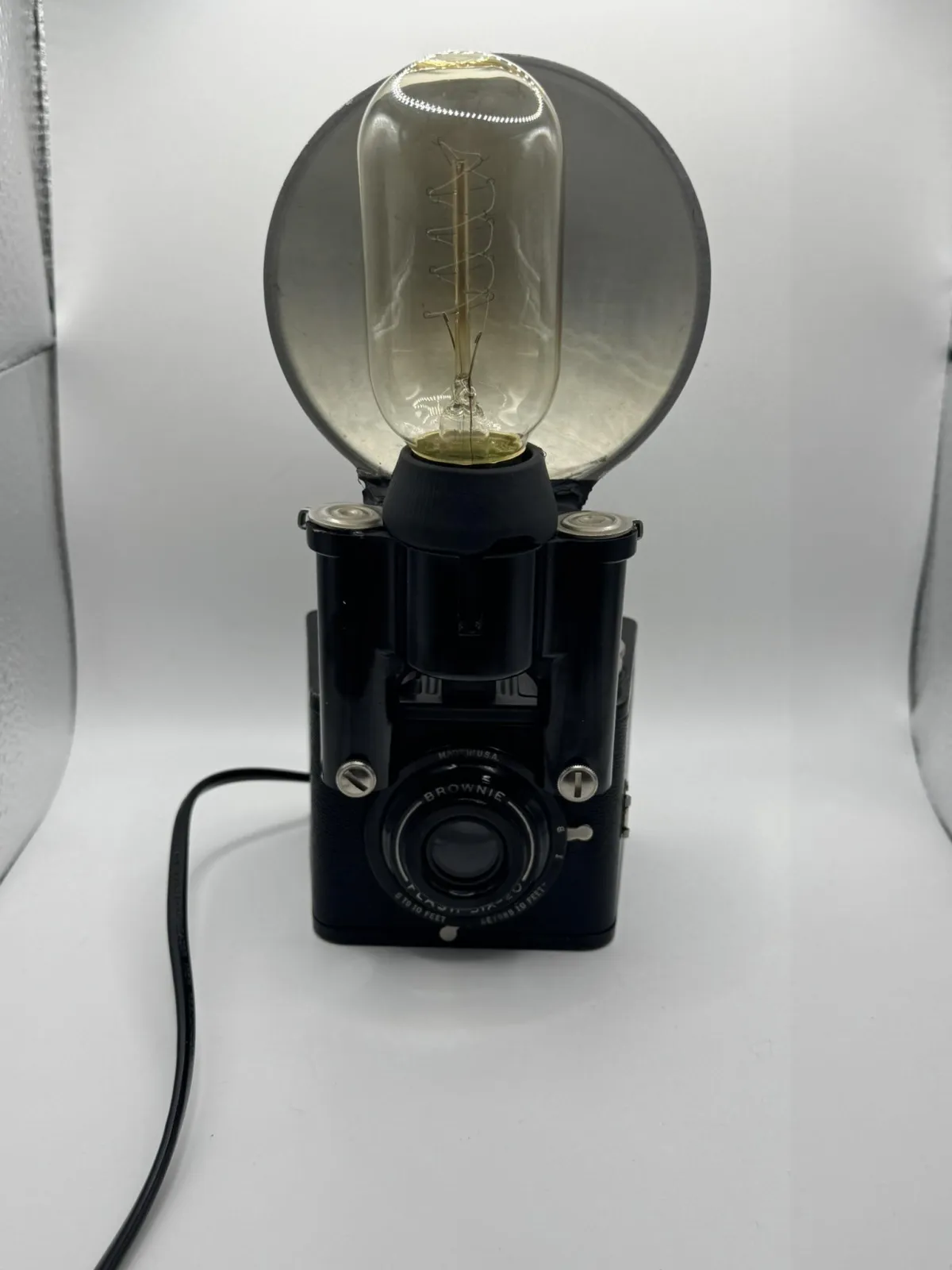
Kodak Brownie Flash 6 - Custom Lamp
Eastman Kodak Company
Kodak Brownie Reflex (1940–1952)
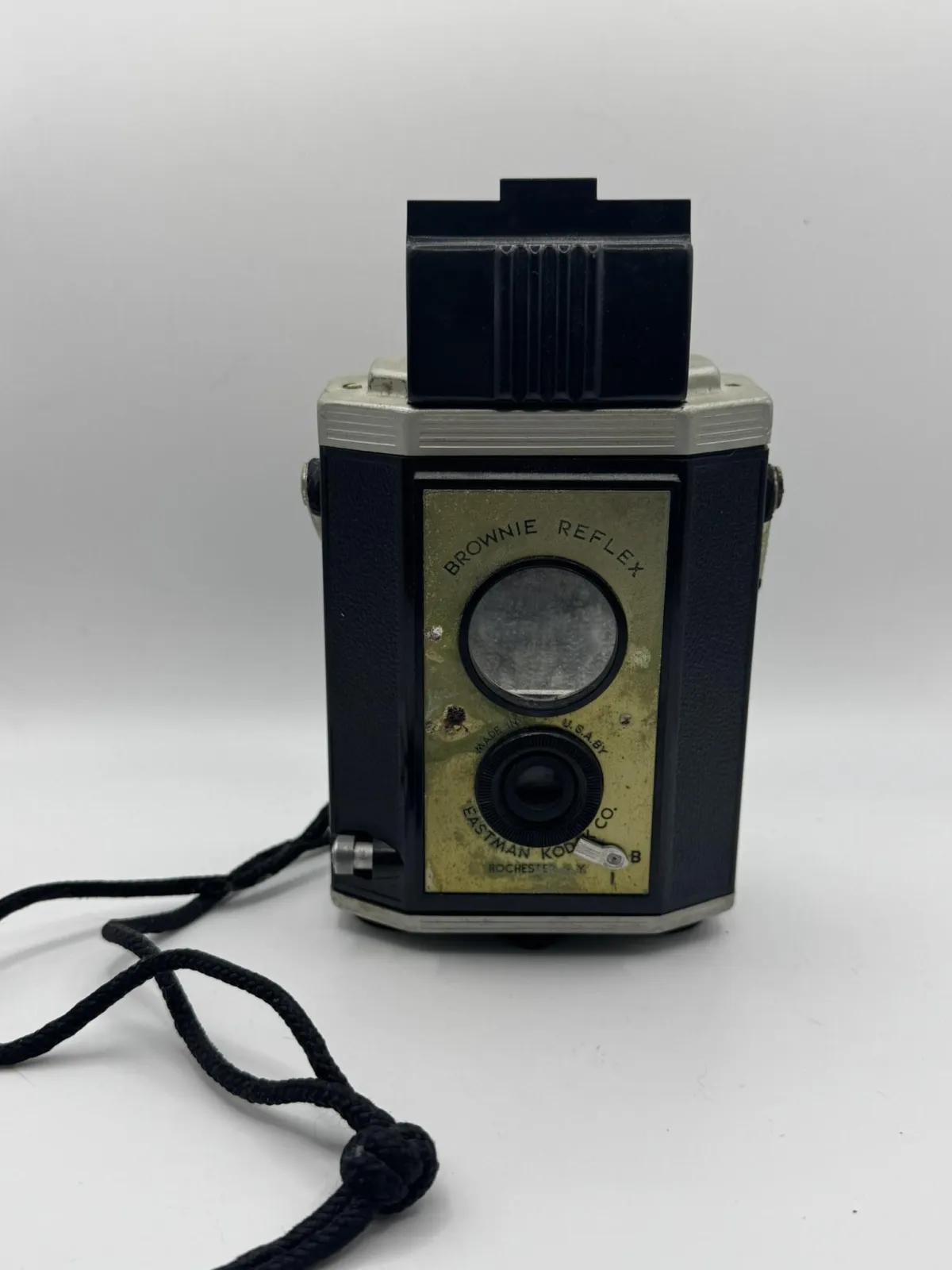
The Kodak Brownie Reflex, produced by Eastman Kodak in Rochester, NY, is a twin-lens reflex style camera designed for simplicity and affordability. Manufactured between 1940 and 1952, it was part of Kodak’s famous Brownie line, which helped bring photography to the masses in the early and mid-20th century.
The Brownie Reflex used 127 roll film, offering 12 exposures per roll, and featured a waist-level viewfinder for easy composition. Its simple fixed-focus meniscus lens and single shutter speed made it approachable for amateur photographers of the era.
Eastman Kodak Company
Brownie Six-20, Model D (1946–1957)
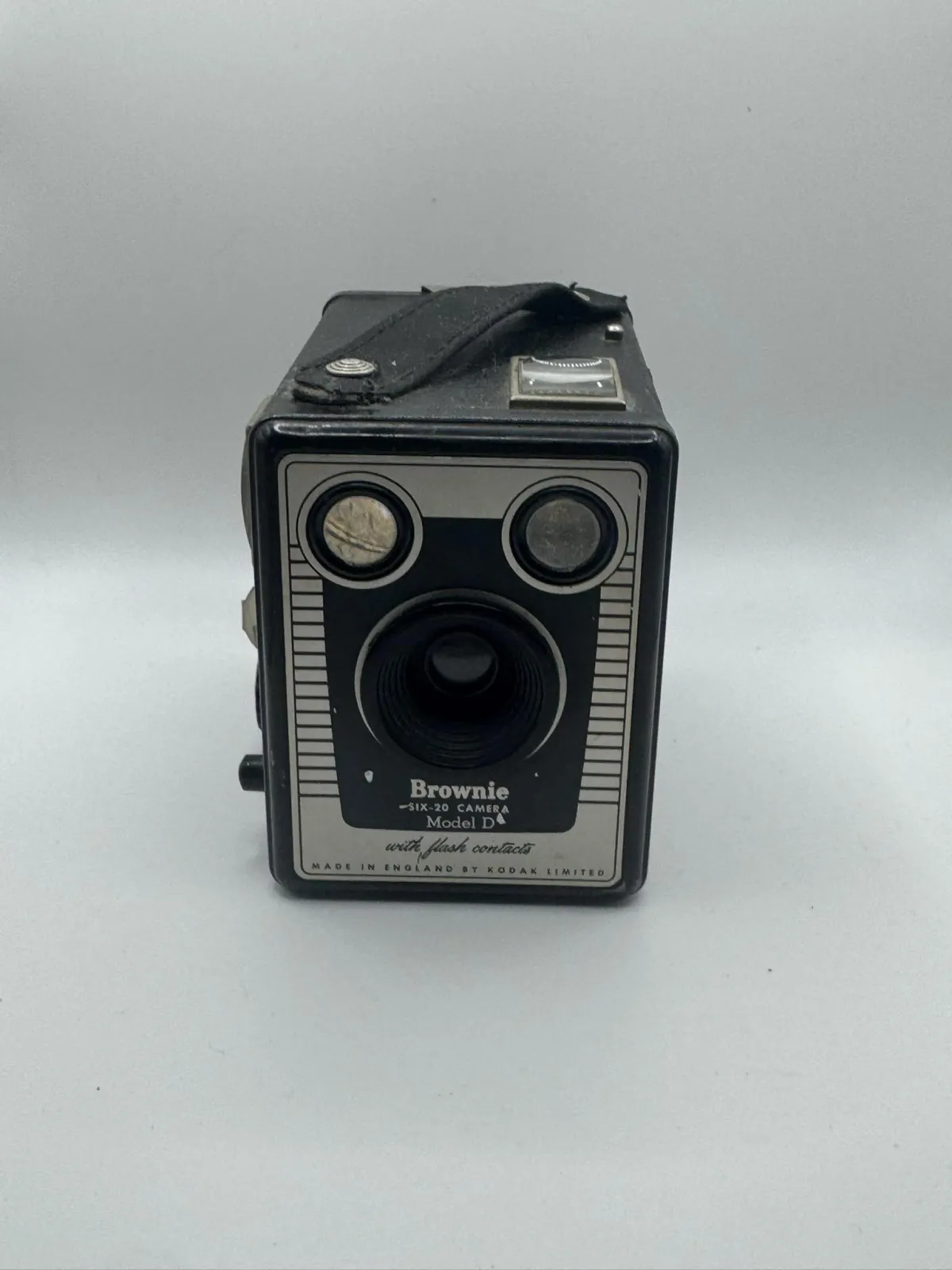
Made in England by Kodak Limited, the Brownie Six-20 Model D was introduced in 1946 as a successor in the popular Brownie box camera line. Designed for 620 roll film, it produced 2¼ × 3¼ inch negatives, making it a favorite among amateur photographers for its ease of use and sturdy build.
This model featured simple controls, a fixed-focus lens, and came equipped with flash contacts for use with external flash units—a step up from earlier Brownie designs. Its reliability and low cost helped democratize photography in the post-war years.
Beacon Two-Twenty Five Camera
(Early 1950s)
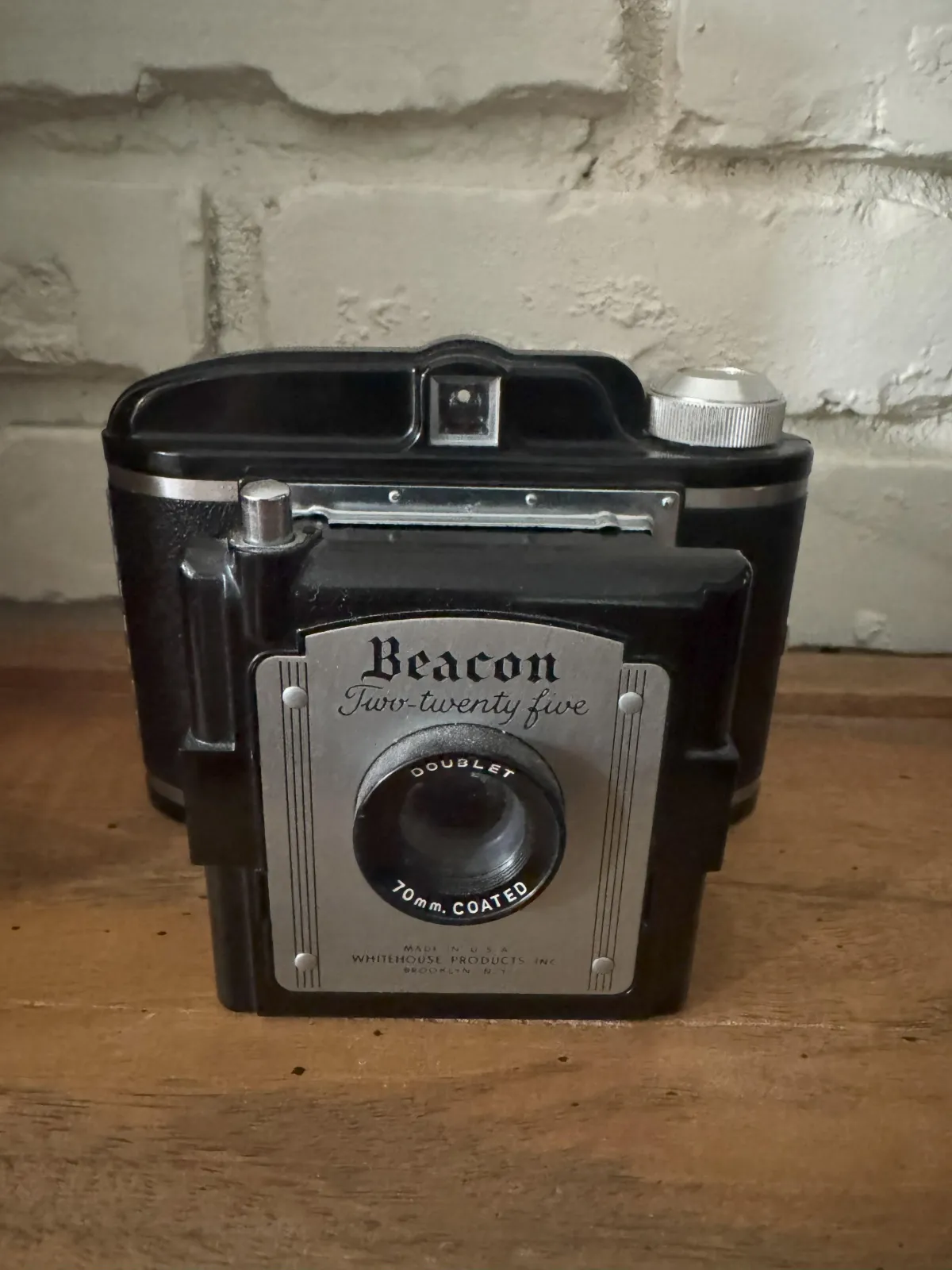
Manufactured by Whitehouse Products, Inc., Brooklyn, NY, the Beacon Two-Twenty Five was introduced in the early 1950s as an affordable, stylish snapshot camera. It features a Beacon Doublet 70mm coated lens and was designed for vest-pocket-sized 620 roll film, producing 2¼ × 2¼ inch negatives.
The Beacon series was marketed as a simple-to-use "family camera" during the postwar era, appealing to casual photographers who wanted convenience and modern design at a low cost. Its bold Art Deco-inspired styling makes it a collectible piece today, especially for display or vintage photography collections.
Key Features:
70mm Coated Doublet Lens
Uses 620 Roll Film (producing 2¼ × 2¼ inch images)
Plastic body with chrome trim
Made in USA (Brooklyn, NY)
Popular mid-century snapshot camera
Collectible Value: The Beacon Two-Twenty Five is sought after by camera collectors and mid-century enthusiasts. While not rare, it represents the fun, affordable photography boom of the 1950s. Its distinctive design makes it a great conversation piece, whether displayed in a collection, on a shelf, or in a photography-themed décor setting.
Kodak Brownie Bullet Camera
(1957–1964)
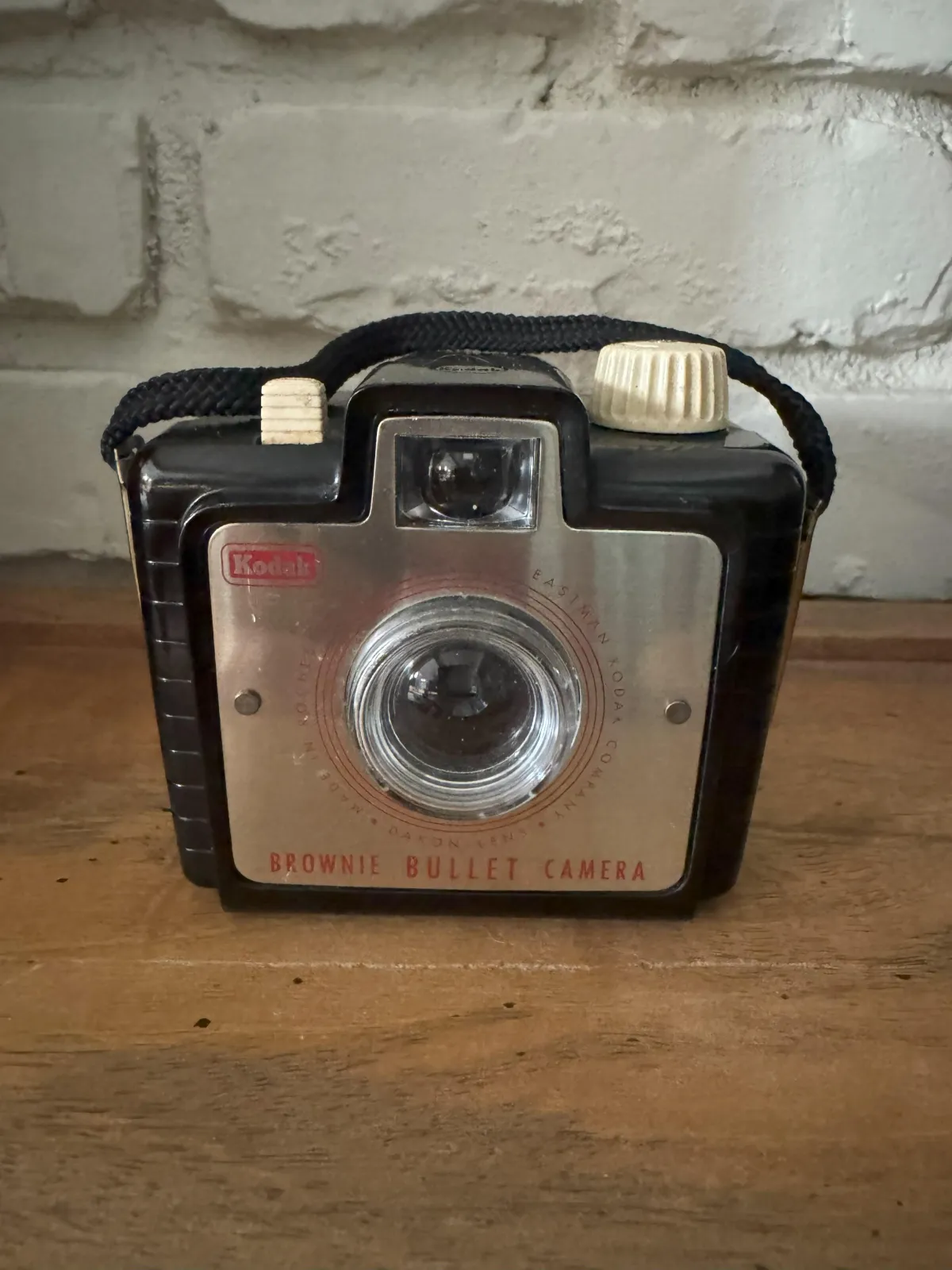
The Kodak Brownie Bullet is a classic mid-century box camera made in the USA by the Eastman Kodak Company. Introduced in 1957, it was part of Kodak’s famous “Brownie” line, which made photography affordable and easy for the average family. This compact camera used 127 roll film, producing 4 × 4 cm square images. It featured a fixed-focus meniscus lens and a single shutter speed, making it simple and reliable—perfect for capturing family snapshots, vacations, and everyday memories.
The Brownie Bullet’s streamlined black Bakelite body, metal faceplate, and red detailing reflected the postwar modern design aesthetic. Its portability and ease of use made it one of Kodak’s most popular consumer cameras of its era.
Key Features:
Manufactured: 1957–1964
Film: 127 roll film (4 × 4 cm negatives)
Lens: Fixed-focus meniscus
Body: Black Bakelite with metal front plate
Viewfinder: Optical direct view
Made in USA by Eastman Kodak Co.
Collectible Value: The Kodak Brownie Bullet is a desirable piece for collectors of vintage Kodak products and mid-century Americana. While millions were produced, examples in good condition remain popular for display and nostalgic collections. Its iconic design makes it a perfect conversation starter or decorative piece.
Kodak Six-20 Folding Camera
(c. 1930s–1940s)
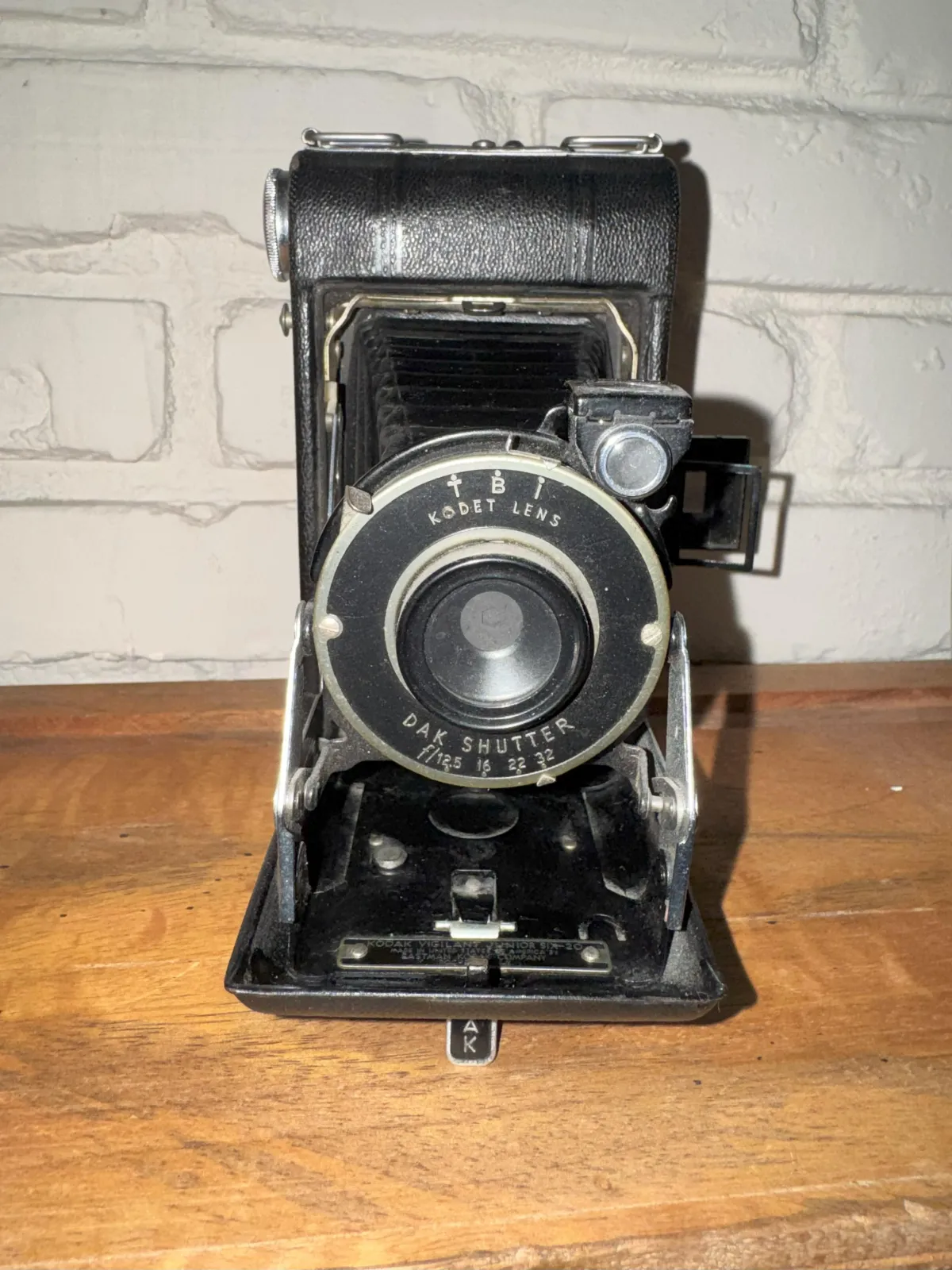
The Kodak Six-20 folding camera was a popular mid-20th-century model produced by the Eastman Kodak Company. Compact and portable, it folded flat for easy carrying, making it ideal for family outings and travel.
This camera used 620 roll film, producing large 6 × 9 cm negatives—perfect for sharp contact prints. It features a Kodet lens paired with a DAK shutter, offering selectable apertures (f/12.5, f/16, f/22, f/32) and shutter speeds including Time, Bulb, and Instant.
Designed for the everyday photographer, the Six-20 combined affordability with quality, part of Kodak’s mission to bring photography to the masses. Today, it stands as a fine example of pre- and post-war photographic technology.
Key Features:
Produced: late 1930s–1940s
Film: 620 roll film (6 × 9 cm negatives)
Lens: Kodak Kodet Lens
Shutter: Kodak DAK shutter (Time, Bulb, Instant)
Apertures: f/12.5, f/16, f/22, f/32
Folding bellows design for portability
Made in USA by Eastman Kodak Co.
Collectible Value: The Kodak Six-20 folding cameras are well-regarded by collectors for their craftsmanship and design. They display beautifully in collections of vintage cameras, and their bellows-and-metal construction captures the essence of early 20th-century photography.
Spartus "35 F" Model 400
(c. 1947 – 1954)
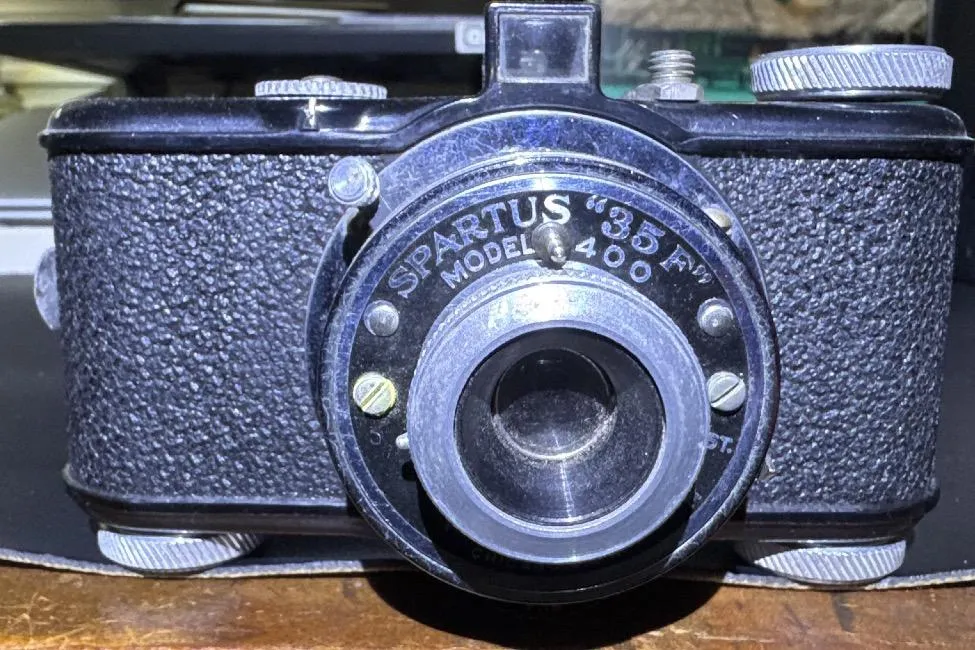
The Spartus "35 F" Model 400 is a classic example of a post-WWII American budget camera, part of the "Chicago Camera" manufacturing movement that provided simple, inexpensive photography to the masses. It is valued today for its distinct vintage aesthetic and low-fidelity image quality.
Technical Features
The Model 400 was designed for ease of use rather than technical precision:
Lens: Fixed-focus, single-element lens (often a Graf Achromat 50mm f/7.7). This contributes to its characteristic soft focus and low-contrast images.
Focusing: Fixed focus or basic scale focusing; it does not require precise focusing adjustments.
Shutter: Extremely simple mechanical leaf shutter with only two modes:
"I" (Instant): A single fixed speed, typically around 1/50th of a second.
"T" (Time): Shutter remains open as long as the lever is held.
Aperture Control: Features a simple rotating plate with a few fixed stops for exposure control (e.g., f/7.7, f/11, f/16).
Flash: The "F" in the name signifies its inclusion of a flash synchronization terminal for use with an external flash unit.
Collectibility and Legacy
The Spartus 35 F is a sought-after piece for collectors interested in the history of American consumer photography and the distinct style of the Chicago camera industry. It is often used by modern film photographers who appreciate the "lo-fi" and "lomo" aesthetics its simple optics naturally produce..
Kodak Instamatic 104
(c. 1965 – 1968)
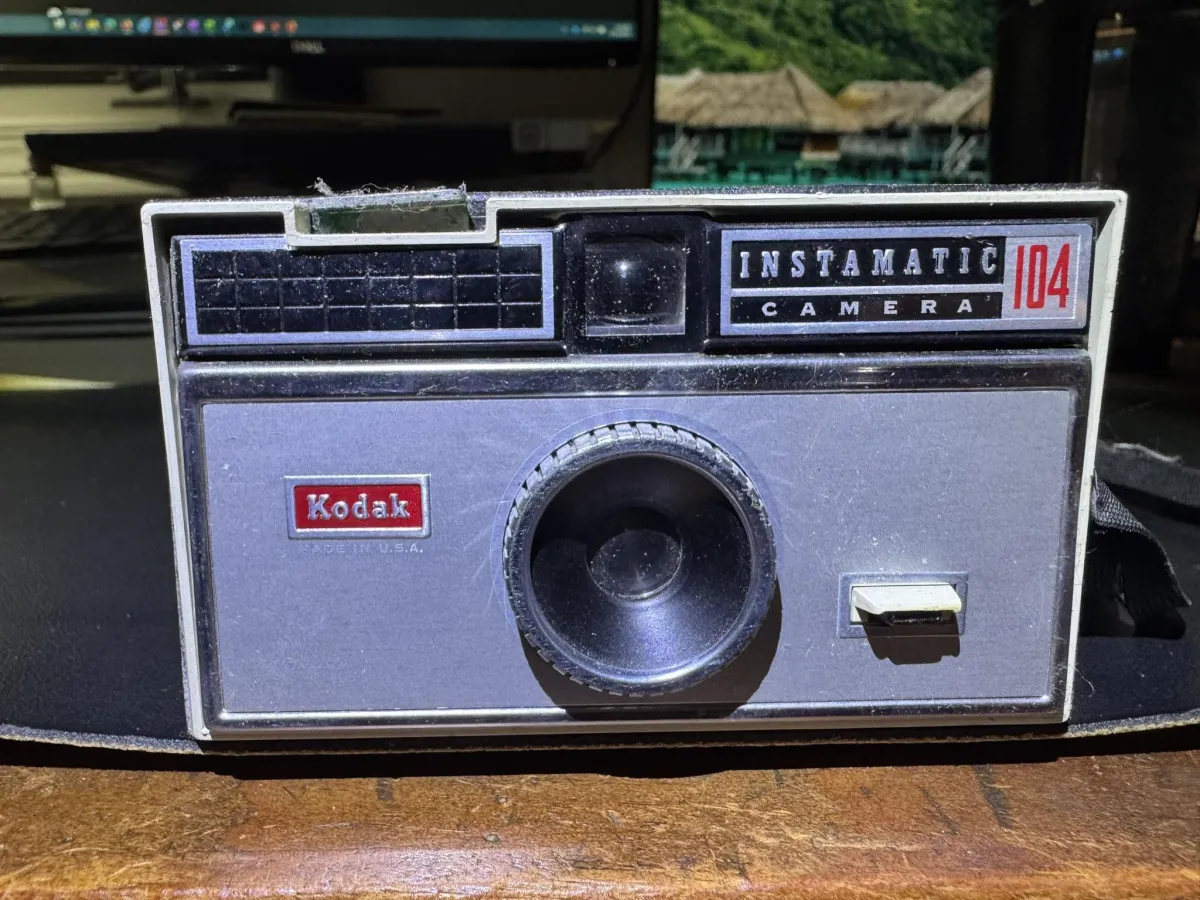
The Kodak Instamatic 104, produced from 1965 to 1968, was a cornerstone of the Instamatic family—a line that brought photography into millions of homes. Its success lay in simplifying the process of picture-taking, making it truly accessible to the casual photographer.
Technical Features
The Instamatic 104 was designed purely for simplicity and speed:
Film Loading: Revolutionized photography by using the 126 film cartridge, which eliminated the need for manual film threading—you simply dropped the cartridge into the camera back.
Lens: Simple, fixed-focus optics (e.g., $43\text{mm}$ at $f/11$) designed for general daylight shooting.
Shutter: Two fixed mechanical speeds automatically selected based on flash attachment:
Daylight: $\sim 1/90\text{ sec}$
Flash: $\sim 1/40\text{ sec}$
Flash System: It was an early adopter of the FlashCube format. The cube contained four single-use flash bulbs and would automatically rotate after each shot to position a fresh bulb.
Legacy and Collectibility
The Instamatic 104 represents a key turning point in consumer electronics and photography, making it a vital piece for collectors of mid-century design and photographic history. While the original 126 film is no longer produced, the camera remains a popular display piece and a reminder of Kodak's dominance in the mass market of the 1960s.
.
Contact Jody w/ Merch Retail Co. for additional information or if you are looking for a specific camera.